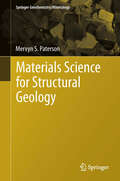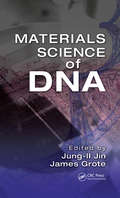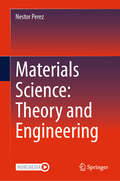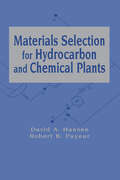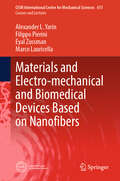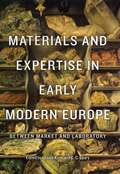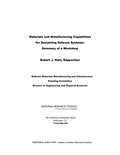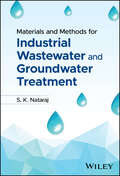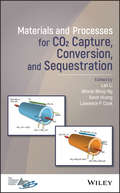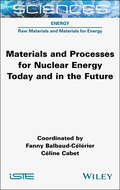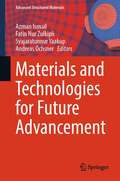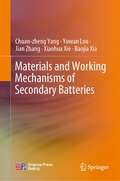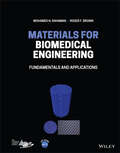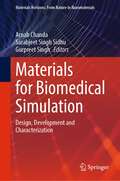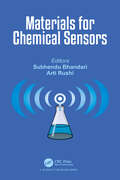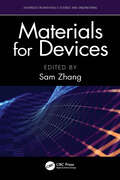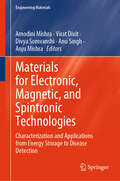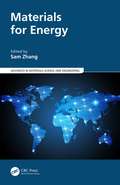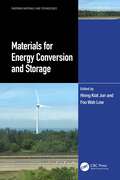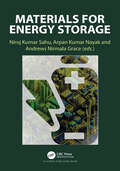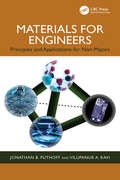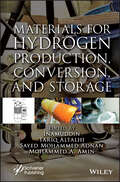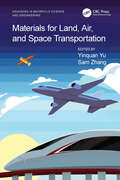- Table View
- List View
Materials Science for Structural Geology
by Mervyn S. PatersonThis book sets out the basic materials science needed for understanding the plastic deformation of rocks and minerals. Although at atmospheric pressure or at relatively low environmental pressures, these materials tend to be brittle, that is, to fracture with little prior plastic deformation when non-hydrostatically stressed, they can undergo substantial permanent strain when stressed under environmental conditions of high confining pressure and high temperature, such as occur geologically in the Earth's crust and upper mantle. Thus the plastic deformation of rocks and minerals is of fundamental interest in structural geology and geodynamics. In mountain-building processes and during convective stirring in the Earth's mantle, rocks can undergo very large amounts of plastic flow, accompanied by substantial changes in microstructure. These changes in microstructure remain in the rocks as evidence of the past deformation history. There are a number of types of physical processes whereby rock and minerals can undergo deformation under geological conditions. The physics of these processes is set out in this book.
Materials Science of DNA
by James Grote Jung-Ii JinThe field of materials science and technology has undergone revolutionary advances due to the development of novel analytical tools, functional materials, and multidisciplinary approaches to engineering. Additionally, theoretical predictions combined with increasingly improved models and computational capabilities are making impressive contribution
Materials Science: Theory and Engineering
by Nestor PerezThis textbook presents a compilation of class-tested materials and the results of research on a range of topics in into one comprehensive volume for readers engaged in the materials science and engineering aspects of phase transformation in metals. Accordingly, this is a suitable textbook for undergraduate and graduate students in the fields of mechanical engineering, materials science, metallurgical engineering, and related disciplines. The book incorporates two-dimensional materials, crystal defects, mass transport, thermodynamics of phase, solidification heat transfer, solidification and phase diagrams related to nucleation particle phases and explains solid-state phase transformation, mechanical behaviour and fracture toughness, non-destructive methods, physical and optical properties of solids, and electrochemical corrosion. It also stands as an excellent reference treatise for practicing and consulting engineers. Moreover, the book is appropriate for graduate-level coursework, covering advanced subjects including quantum mechanics, two dimensional materials, fracture mechanics, non-destructive methods for evaluating structural integrity, and advanced analytical techniques in some appendices.
Materials Selection for Hydrocarbon and Chemical Plants
by HansenDescribes the systematic procedure for using process and mechanical design information to select construction materials suitable for a range of chemical and hydrocarbon processing plants. The volume features tables for locating the American Society for Testing and Materials (ASTM) product form specifications for construction materials that have code-allowable design stresses. It analyzes threshold values for degradation phenomena involving thermal damage.
Materials and Electro-mechanical and Biomedical Devices Based on Nanofibers (CISM International Centre for Mechanical Sciences #611)
by Alexander L. Yarin Filippo Pierini Eyal Zussman Marco LauricellaThe book is interwoven according to the intrinsic logics of modern most important applications of electrospun nanofibers. It discusses such application-oriented nanofibers as self-healing vascular nanotextured materials, biopolymer nanofibers, soft robots and actuators based on nanofibers, biopolymer nanofiber-based triboelectric nanogenerators, metallized nanofibers, and heaters and sensors based on them. It also includes such topics as the injectable nanofibrous biomaterials, fibrous hemostatic agents and their interaction with blood, as well as electrospun nanofibers for face-mask applications. The book also details polyelectrolytes-based complex nanofibers and their use as actuators. It also covers drug release facilitated by polyelectrolytes-based complex nanofibers. The fundamental aspects of electrospinning of polymer nanofibers discussed in the final part of the book link them to the applications described in the preceding chapters. Such topics as polymer solution preparation and their rheological properties, e.g., viscoelasticity and the related spinnability, the electrical conductivity of polymer solutions, and the cascade of the physical phenomena resulting in formation of nanofibers encompass the experimental aspects. Also, the general quasi-1D equations used for modeling of formation of electrospun polymer nanofibers, and the numerical aspects of their solution are discussed in detail, including such modeling-driven applications as nanofiber alignment by electric focusing fields.
Materials and Expertise in Early Modern Europe: Between Market and Laboratory
by Ursula Klein E. C. SparyIt is often assumed that natural philosophy was the forerunner of early modern natural sciences. But where did these sciences' systematic observation and experimentation get their starts? In Materials and Expertise in Early Modern Europe, the laboratories, workshops, and marketplaces emerge as arenas where hands-on experience united with higher learning. In an age when chemistry, mineralogy, geology, and botany intersected with mining, metallurgy, pharmacy, and gardening, materials were objects that crossed disciplines. Here, the contributors tell the stories of metals, clay, gunpowder, pigments, and foods, and thereby demonstrate the innovative practices of technical experts, the development of the consumer market, and the formation of the observational and experimental sciences in the early modern period. Materials and Expertise in Early Modern Europe showcases a broad variety of forms of knowledge, from ineffable bodily skills and technical competence to articulated know-how and connoisseurship, from methods of measuring, data gathering, and classification to analytical and theoretical knowledge. By exploring the hybrid expertise involved in the making, consumption, and promotion of various materials, and the fluid boundaries they traversed, the book offers an original perspective on important issues in the history of science, medicine, and technology.
Materials and Manufacturing Capabilities for Sustaining Defense Systems
by National Research Council Division on Engineering and Physical Sciences Defense Materials Manufacturing and Infrastructure Standing Committee Robert J. KattThe Standing Committee on Defense Materials Manufacturing and Infrastructure (DMMI) conducted a workshop on July 23-24, 2012, to share information and gather perspectives on issues concerning Materials and Manufacturing Capabilities for Sustaining Defense Systems. This workshop, held at the headquarters building of the National Academies, 2101 Constitution Avenue N.W., Washington D.C., was conducted according to the procedures of the National Research Council (NRC) for a convening activity. That is, all workshop participants--including presenters, members of the DMMI standing committee, Reliance 21, invited guests, and visitors--spoke as individuals, and no overall findings, conclusions, or recommendations were developed during or as a result of the workshop. All statements and views summarized in this publication are attributable only to those individuals who expressed them. It is worth noting that the sponsor, Reliance 21, is a Department of Defense group of professionals that was established to enable the DOD science and technology (S&T) community to work together to enhance Defense S&T programs, eliminate unwarranted duplication, and strengthen cooperation among the military services and other DOD agencies. The DMMI standing committee named a workshop planning group to develop the workshop agenda and decide on invited guests and presenters, in accordance with the statement of task approved by the Governing Board of the NRC. The planning group also consulted with the Reliance 21 materials and processing community of interest. The presentations and discussions during the workshop are summarized sequentially in the main part of this report. As an aid to readers, nine themes have been identified by the author that recurred in multiple presentations and discussions. Materials and Manufacturing Capabilities for Sustaining Defense Systems: Summary of a Workshop explains these nine themes and summarizes the two day workshop.
Materials and Methods for Industrial Wastewater and Groundwater Treatment
by S. K. NatarajAn expert synthesis of the latest materials and methods with applications for groundwater and wastewater treatment Materials and Methods for Industrial Wastewater and Groundwater Treatment delivers an up-to-date discussion of the materials and methods being used to address the problem of pollutants in industrial wastewaters and groundwater. The book describes innovative new materials with significant potential to emerge as a next-generation solution in the water treatment space. Cutting-edge research is synthesized into these novel materials and methods and case studies demonstrate real-world applications of new solutions for water treatment. Readers will also find: A thorough introduction to new materials and techniques for treating wastewater and groundwater to remove pollutantsComprehensive explorations of the latest research on commercially viable methods for treating wastewater and groundwaterCase studies highlighting the practical application of novel methods and materials as next-generation solutions for water treatment Perfect for industrial chemists, environmental and material researchers and supervisors, and consulting and design engineers in wastewater treatment plants, Materials and Methods for Industrial Wastewater and Groundwater Treatment will also benefit design professionals, materials scientists, and environmental engineers with an interest in nanomaterial applications to wastewater treatments.
Materials and Processes
by Barrie D. DunnThe objective of this book is to assist scientists and engineers select the ideal material or manufacturing process for particular applications; these could cover a wide range of fields, from light-weight structures to electronic hardware. The book will help in problem solving as it also presents more than 100 case studies and failure investigations from the space sector that can, by analogy, be applied to other industries. Difficult-to-find material data is included for reference. The sciences of metallic (primarily) and organic materials presented throughout the book demonstrate how they can be applied as an integral part of spacecraft product assurance schemes, which involve quality, material and processes evaluations, and the selection of mechanical and component parts. In this successor edition, which has been revised and updated, engineering problems associated with critical spacecraft hardware and the space environment are highlighted by over 500 illustrations including micrographs and fractographs. Space hardware captured by astronauts and returned to Earth from long durations in space are examined. Information detailed in the Handbook is applicable to general terrestrial applications including consumer electronics as well as high reliability systems associated with aeronautics, medical equipment and ground transportation. This Handbook is also directed to those involved in maximizing the relia bility of new materials and processes for space technology and space engineering. It will be invaluable to engineers concerned with the construction of advanced structures or mechanical and electronic sub-systems.
Materials and Processes for CO2 Capture, Conversion, and Sequestration
by Winnie Wong-Ng Lan Li Kevin Huang Lawrence P. CookAddresses materials, technology, and products that could help solve the global environmental crisis once commercialized This multidisciplinary book encompasses state-of-the-art research on the topics of Carbon Capture and Storage (CCS), and complements existing CCS technique publications with the newest research and reviews. It discusses key challenges involved in the CCS materials design, processing, and modeling and provides in-depth coverage of solvent-based carbon capture, sorbent-based carbon capture, membrane-based carbon capture, novel carbon capture methods, computational modeling, carbon capture materials including metal organic frameworks (MOF), electrochemical capture and conversion, membranes and solvents, and geological sequestration. Materials and Processes for CO2 Capture, Conversion and Sequestration offers chapters on: Carbon Capture in Metal-Organic Frameworks; Metal Organic Frameworks Materials for Post-Combustion CO2 Capture; New Progress of Microporous Metal-Organic Frameworks in CO2 Capture and Separation; In Situ Diffraction Studies of Selected Metal-Organic Framework (MOF) Materials for Guest Capture Applications; Electrochemical CO2 Capture and Conversion; Electrochemical Valorization of Carbon Dioxide in Molten Salts; Microstructural and Structural Characterization of Materials for CO2 Storage using Multi-Scale X-Ray Scattering Methods; Contribution of Density Functional Theory to Microporous Materials for Carbon Capture; and Computational Modeling Study of MnO2 Octahedral Molecular Sieves for Carbon Dioxide Capture Applications. Addresses one of the most pressing concerns of society—that of environmental damage caused by the greenhouse gases emitted as we use fossil fuels Covers cutting-edge capture technology with a focus on materials and technology rather than regulation and cost Highlights the common and novel CCS materials that are of greatest interest to industrial researchers Provides insight into CCS materials design, processing characterization, and computer modeling Materials and Processes for CO2 Capture, Conversion and Sequestration is ideal for materials scientists and engineers, energy scientists and engineers, inorganic chemists, environmental scientists, pollution control scientists, and carbon chemists.
Materials and Processes for Nuclear Energy Today and in the Future (ISTE Consignment)
by Fanny Balbaud-Célérier Céline CabetAs a low carbon energy source, nuclear energy plays a reinforced role in a sustainable electricity mix. However, strengthening the share of nuclear energy implies the guarantee of safe, long-term operation of current systems and potentially the fostering of new constructions. Service life extension – as well as the design of future nuclear power plants – relies on the availability of robust and qualified structural materials, and their manufacturing processes. The science and engineering of materials are key in selecting robust material solutions and predicting aging mechanisms. Materials and Processes for Nuclear Energy Today and in the Future reviews different reactor concepts and fuel management systems. Nuclear equipment has to maintain integrity under extreme conditions, such as high temperature, radiation, loads and/or corrosive environments. This book analyzes the requirements on components, and introduces reference solutions regarding materials and processes. It describes the materials’ main properties, their limits and the current R&D trends. Lastly, innovations are discussed, such as materials with enhanced properties, advanced manufacturing or using AI.
Materials and Technologies for Future Advancement (Advanced Structured Materials #193)
by Andreas Öchsner Azman Ismail Fatin Nur Zulkipli Syajaratunnur YaakupThis book is a platform to publish new progress in the field of materials and technologies that can offer significant developments with the possibility of changing the future. These emerging developments will change the way we live now at an unprecedented pace across our society. It is important to note that such modern developments are no longer restricted to a single discipline, but are the outcome of a multidisciplinary approach, which combines many different engineering disciplines. This book explores the new technology landscape that will have the direct impact on production-related sectors, individually and in combination with different disciplines. A major driver for this actual research is the efficiency, many times connected with a focus on environmental sustainability.
Materials and Working Mechanisms of Secondary Batteries
by Jian Zhang Chuan-zheng Yang Yuwan Lou Xiaohua Xie Baojia XiaThis book provides a description of material characterization and mechanisms of secondary batteries during discharge, cycle, and storage process. It also proposes a new intercalation/de-intercalation theory and presents the mechanism of ionic conduction. In addition, through the comparative study of variation laws of battery performance and of fine structure and microstructure parameters, the mechanism of cycle and storage processes and battery performance decay are investigated. Given its scope, the book appeals to a broad readership, particularly professionals at universities and scientific research institutes.
Materials for Biomedical Engineering: Fundamentals and Applications
by Mohamed N. Rahaman Roger F. BrownMATERIALS FOR BIOMEDICAL ENGINEERING A comprehensive yet accessible introductory textbook designed for one-semester courses in biomaterials Biomaterials are used throughout the biomedical industry in a range of applications, from cardiovascular devices and medical and dental implants to regenerative medicine, tissue engineering, drug delivery, and cancer treatment. Materials for Biomedical Engineering: Fundamentals and Applications provides an up-to-date introduction to biomaterials, their interaction with cells and tissues, and their use in both conventional and emerging areas of biomedicine. Requiring no previous background in the subject, this student-friendly textbook covers the basic concepts and principles of materials science, the classes of materials used as biomaterials, the degradation of biomaterials in the biological environment, biocompatibility phenomena, and the major applications of biomaterials in medicine and dentistry. Throughout the text, easy-to-digest chapters address key topics such as the atomic structure, bonding, and properties of biomaterials, natural and synthetic polymers, immune responses to biomaterials, implant-associated infections, biomaterials in hard and soft tissue repair, tissue engineering and drug delivery, and more. Offers accessible chapters with clear explanatory text, tables and figures, and high-quality illustrations Describes how the fundamentals of biomaterials are applied in a variety of biomedical applications Features a thorough overview of the history, properties, and applications of biomaterials Includes numerous homework, review, and examination problems, full references, and further reading suggestions Materials for Biomedical Engineering: Fundamentals and Applications is an excellent textbook for advanced undergraduate and graduate students in biomedical materials science courses, and a valuable resource for medical and dental students as well as students with science and engineering backgrounds with interest in biomaterials.
Materials for Biomedical Simulation: Design, Development and Characterization (Materials Horizons: From Nature to Nanomaterials)
by Gurpreet Singh Sarabjeet Singh Sidhu Arnab ChandaThe book provides an overview of prospective material simulants for hard tissues, such as knee joints, hip joint, and bones, and soft tissues, such as skin, muscles, and functional organs. These materials can repair, replace the functionality, or mimic the mechanical, structural, and biological properties of the parent tissue. This book discusses hard and soft human tissue simulating biomaterials under a single umbrella, covering a broad area of design and development of biomaterials, implants, and multi-functional materials along with their characterization. The progress in emerging biomaterials has increased manifold in the recent decades with the unprecedented focus on healthcare technologies. This book is dedicated to ground-breaking research in biomaterials and highlights the current trends and future roadmap of different materials for simulation of hard and soft tissues. Authored by prominent researchers around the globe, the chapters of this book emphasize recent advances in biomedical material simulation. This book brings together novel contributions to different aspects of hard and soft human tissue-based biomaterials, including recent advances and emerging developments in designing and developing simulants for tissue replacement alternatives. This book is anticipated to serve as a key reference textbook for research in tissue engineering & biomedical engineering, biomaterials, biomechanics, and implant & medical device development with contributed chapters solicited in the areas of soft materials, such as elastomers, hydrogels, etc., for various applications; auxetic metamaterials; additive manufacturing of bio-implants; artificial tissues and organs; development of biomimetic materials; medical implants and biomedical device design; bioinspired and bio-tribological materials; advances in materials science for biomaterial applications; biomechanical characterization of hard and soft human tissues; bioprinting and nano-biomaterials.
Materials for Carbon Capture
by De-En JiangCovers a wide range of advanced materials and technologies for CO2 capture As a frontier research area, carbon capture has been a major driving force behind many materials technologies. This book highlights the current state-of-the-art in materials for carbon capture, providing a comprehensive understanding of separations ranging from solid sorbents to liquid sorbents and membranes. Filled with diverse and unconventional topics throughout, it seeks to inspire students, as well as experts, to go beyond the novel materials highlighted and develop new materials with enhanced separations properties. Edited by leading authorities in the field, Materials for Carbon Capture offers in-depth chapters covering: CO2 Capture and Separation of Metal-Organic Frameworks; Porous Carbon Materials: Designed Synthesis and CO2 Capture; Porous Aromatic Frameworks for Carbon Dioxide Capture; and Virtual Screening of Materials for Carbon Capture. Other chapters look at Ultrathin Membranes for Gas Separation; Polymeric Membranes; Carbon Membranes for CO2 Separation; and Composite Materials for Carbon Captures. The book finishes with sections on Poly(amidoamine) Dendrimers for Carbon Capture and Ionic Liquids for Chemisorption of CO2 and Ionic Liquid-Based Membranes. A comprehensive overview and survey of the present status of materials and technologies for carbon capture Covers materials synthesis, gas separations, membrane fabrication, and CO2 removal to highlight recent progress in the materials and chemistry aspects of carbon capture Allows the reader to better understand the challenges and opportunities in carbon capture Edited by leading experts working on materials and membranes for carbon separation and capture Materials for Carbon Capture is an excellent book for advanced students of chemistry, materials science, chemical and energy engineering, and early career scientists who are interested in carbon capture. It will also be of great benefit to researchers in academia, national labs, research institutes, and industry working in the field of gas separations and carbon capture.
Materials for Chemical Sensors
by Subhendu Bhandari Arti RushiApplication as well as detection of different chemicals plays an important role in the progress of modern science and technology. The beauty of various characteristics of materials and the inherent logic behind their working mechanisms can be wisely utilized for sensing different chemicals. The mechanisms as well as performances of different materials viz. carbon nanotube, graphene, metal oxides, biomaterials, luminescent metal-organic frameworks, hydrogels, textiles, quantum dots, ligands, crown ethers etc. for identification of different chemicals has been discussed here. This book would be a valuable reference to select suitable materials for possible use in chemical sensors.
Materials for Devices (Advances in Materials Science and Engineering)
by Sam ZhangFrom everyday applications to the rise of automation, devices have become ubiquitous. Specific materials are employed in specific devices because of their particular properties, including electrical, thermal, magnetic, mechanical, ferroelectric, and piezoelectric. Materials for Devices discusses materials selection for optimal application and highlights current materials developments in gas sensors, optical devices, mechanoelectrical devices, and medical and biological devices. Explains how to select the right material for the right device Includes 2D materials, thin films, smart piezoelectric films, and more Presents details on organic solar cells Describes thin films in sensors, actuators, and LEDs Covers thin films and elastic polymers in biomedical devices Discusses growth and characterization of intrinsic magnetic topological insulators This work is aimed at researchers, technologists, and advanced students in materials and electrical engineering and related fields who are interested in developing sensors or devices.
Materials for Electronic, Magnetic, and Spintronic Technologies: Characterization and Applications from Energy Storage to Disease Detection (Engineering Materials)
by Amodini Mishra Virat Dixit Divya Somvanshi Anu Singh Anju MishraThis book consolidates the collective contributions of various authors, presenting a diverse array of materials for systematic property assessment and their subsequent application in electronic, magnetic, and spintronic technologies. Encompassing pure and modified polymers, metals, and semiconductors, the book elucidates the magnetic, photocatalytic, thermal, electrochemical, and other salient characteristics inherent in these materials. Delving into a broad spectrum of applications such as energy storage, environmental remediation (water purification), and biomedical (drug administration), the book carefully examines these materials in the context of their distinctive attributes. By elucidating the correlation between a material's functionality and its physical properties, this work offers a lucid and accessible presentation that facilitates an understanding of how these materials can be judiciously employed for specific purposes. Designed for researchers, graduate students, educators, engineers, industry researchers, and other informed members of the public, the comprehensive coverage of this book renders it an indispensable tool in the realm of materials science and technology. Through its meticulous exploration of various materials and their applications, this work stands as a valuable resource for those seeking a profound understanding of the intricate interplay between material properties and their functionalities.
Materials for Energy (Advances in Materials Science and Engineering)
by Sam ZhangMaterials for Energy offers a comprehensive overview of the latest developments in materials for efficient and sustainable energy applications, including energy conversion, storage, and smart applications. Discusses a wide range of material types, such as nanomaterials, carbonaceous electrocatalysts and electrolytes, thin films, phase change materials, 2D energy materials, triboelectric materials, and membrane materials Describes applications that include flexible energy storage devices, sensors, energy storage batteries, fuel and solar cells, photocatalytic wastewater treatment, and more Highlights current developments in energy conversion, storage, and applications from a materials angle Aimed at researchers, engineers, and technologists working to solve alternative energy issues, this work illustrates the state of the art and latest technologies in this important field.
Materials for Energy Conversion and Storage (Emerging Materials and Technologies)
by Hieng Kiat Jun Foo Wah LowDevelopment of new energy‑related materials is essential in addressing future energy demands. Materials for Energy Conversion and Storage focuses on the materials science related to energy conversion and energy storage technologies. It covers the principles of prospective energy technologies and their relationship to the performance of energy devices.• Covers fundamental principles of energy conversion and storage• Discusses materials selection, design, and performance tradeoffs• Details electrochemical cell construction and testing methodologies• Explores sustainable development of energy devices• Features case studiesAimed at readers in materials, electrical, and energy engineering, this book provides readers with a deep understanding of the role of materials in developing sustainable energy devices.
Materials for Energy Storage
by Andrews Nirmala Grace Niroj Kumar Sahu Arpan Kumar NayakMaterials for Energy Storage offers a combinatorial understanding of materials science and electrochemistry in electrochemical energy storage devices with a holistic overview of the status, research gaps, and future opportunities. Rooted in a profound understanding of contemporary energy utilization, aligned with the sustainable development goals, this book delves deep into the several device chemistries, impact of nanomaterials, and critical factors related to the device performance. It discusses electrode-electrolyte interaction, device fabrication, and commercial aspects. This book will offer value to the graduate and postgraduate students, researchers, and industry professionals related to materials science and energy technology.
Materials for Engineers: Principles and Applications for Non-Majors
by Jonathan B. Puthoff Vilupanur A. RaviA working understanding of materials principles is essential in every area of engineering. However, the materials requirements of different engineering disciplines can vary considerably. Existing introductory textbooks on engineering materials adopt a universalist approach, providing theoretical development and surveying a landscape of topics suitable for introducing materials engineers to their field. Materials for Engineers: Principles and Applications for Non-Majors has been constructed with the requirements of non-materials engineering students (“non-majors") in mind. The theoretical foundations of material structure and behavior are curated and focused, and the description of the behavior of materials as they pertain to performance, measurement, and design are developed in detail.The book: Places applications and essential measurement methods before detailed theory Features a variety of types end-of-chapter exercises, including forum discussion topics for online course components Emphasizes computer-based problem solving and includes numerous examples and exercises for MATLAB® Includes optional “topic” chapters for course customization, including structures, transportation, and electronics Outlines practical details of how and why knowledge of materials is necessary for engineers, including the various roles that materials engineers play and the impact of materials on cost, lifespan, and safety of components and products This textbook is aimed at undergraduate engineering students taking their first materials engineering course. It can also be used by professional engineers interested in a ready reference. A solutions manual, lecture slides, and example data sets are available for adopting professors.
Materials for Hydrogen Production, Conversion, and Storage
by Inamuddin Tariq Altalhi Sayed Mohammed Adnan Mohammed A. AminMATERIALS FOR HYDROGEN PRODUCTION, CONVERSION, AND STORAGE Edited by one of the most well-respected and prolific engineers in the world and his team, this book provides a comprehensive overview of hydrogen production, conversion, and storage, offering the scientific literature a comprehensive coverage of this important fuel. Continually growing environmental concerns are driving every, or almost every, country on the planet towards cleaner and greener energy production. This ultimately leaves no option other than using hydrogen as a fuel that has almost no adverse environmental impact. But hydrogen poses several hazards in terms of human safety as its mixture of air is prone to potential detonations and fires. In addition, the permeability of cryogenic storage can induce frostbite as it leaks through metal pipes. In short, there are many challenges at every step to strive for emission-free fuel. In addition to these challenges, there are many emerging technologies in this area. For example, as the density of hydrogen is very low, efficient methods are being developed and engineered to store it in small volumes. This groundbreaking new volume describes the production of hydrogen from various sources along with the protagonist materials involved. Further, the extensive and novel materials involved in conversion technologies are discussed. Also covered here are the details of the storage materials of hydrogen for both physical and chemical systems. Both renewal and non-renewal sources are examined as feedstocks for the production of hydrogen. The non-renewal feedstocks, mainly petroleum, are the major contributor to date but there is a future perspective in a renewal source comprising mainly of water splitting via electrolysis, radiolysis, thermolysis, photocatalytic water splitting, and biohydrogen routes. Whether for the student, veteran engineer, new hire, or other industry professionals, this is a must-have for any library.
Materials for Land, Air, and Space Transportation (Advances in Materials Science and Engineering)
by Sam Zhang Yinquan YuAs transportation systems for land, air, and space vehicles continue to grow increasingly sophisticated, more advanced materials are needed to support their development and commercialization. Materials for Land, Air, and Space Transportation details new materials development for these transportation applications, emphasizing physical properties, research theories, and cutting-edge processing technologies, as well as advanced high-precision inspection methodologies.• Covers materials, design, and manufacturing for lightweight vehicles, high-speed trains, fuel cell vehicles, and aerospace and aeronautical use.• Focuses on the newest material function and processing technologies, covering nanotechnology, modern additive manufacturing techniques, and physical and mechanical studies of structure-sensitive properties of materials.• Describes theoretical deduction, numerical simulation, and experimental studies of various materials.This reference will be of interest to engineers and researchers in the disciplines of materials, mechanical, and transportation engineering, and related areas.
